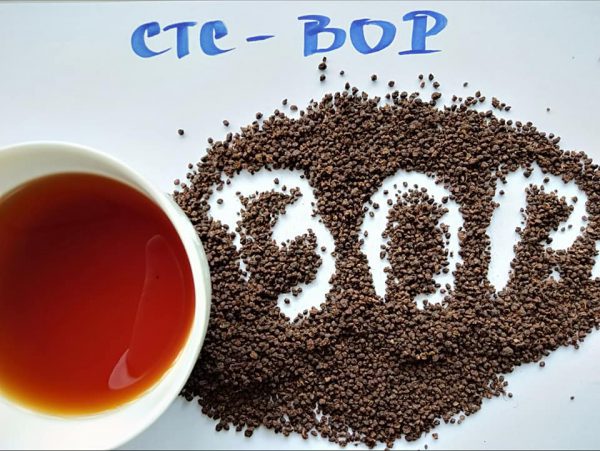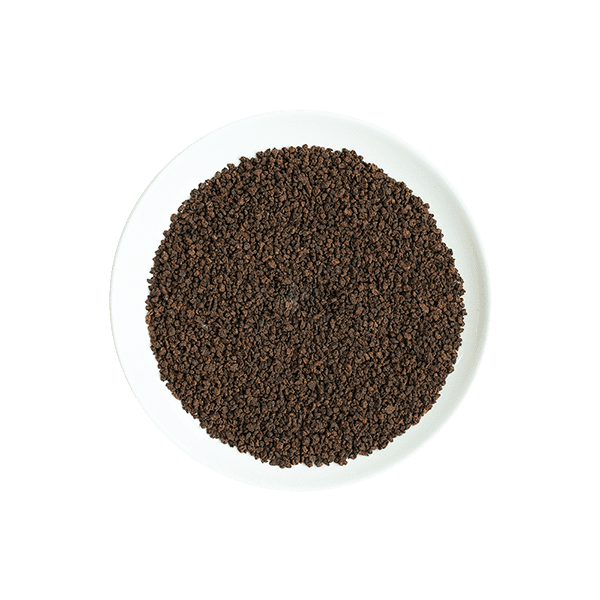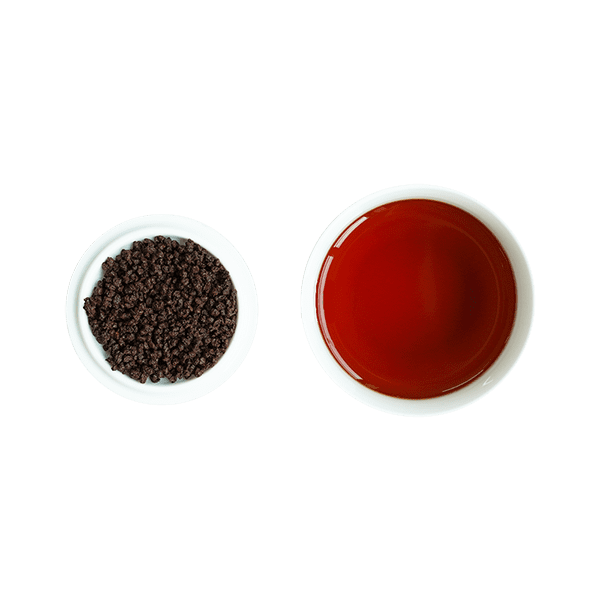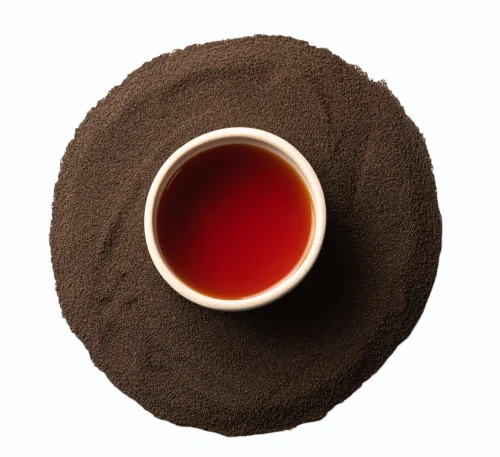Tin tức
CTC Black Tea – BOP: Production Process, Comparison, Applications and International Market Potential
CTC Black Tea – BOP (Broken Orange Pekoe) is a notable grade of black tea processed using the Crush, Tear, Curl (CTC) method. This method produces larger, uniformly sized tea granules, which contribute to its rich, full-bodied flavor. BOP is particularly valued in the production of premium tea products, where quality and consistency are paramount.
In this article, we will explore the production process of CTC Black Tea – BOP, compare it with other CTC grades, discuss its applications in tea blends, and examine the health benefits it offers. Additionally, we will analyze the market trends, factors affecting its quality, and the international standards required for BOP to maintain its high standing in the global tea market.

Contents
- 1 Introduction to CTC Black Tea – BOP
- 2 The Production Process of CTC Black Tea – BOP
- 3 Comparing CTC Black Tea – BOP with Other CTC Grades
- 4 Applications of CTC Black Tea – BOP in Tea Blending
- 5 Health Benefits of CTC Black Tea – BOP
- 6 Market Trends and Consumption of CTC Black Tea – BOP on the International Market
- 7 Factors Affecting the Quality of CTC Black Tea – BOP
- 8 Quality Standards and Certifications for CTC Black Tea – BOP
- 9 History and Development of CTC Black Tea – BOP
- 10 Conclusion
Introduction to CTC Black Tea – BOP
CTC Black Tea – BOP stands out as one of the most distinguished grades within the CTC category. The BOP (Broken Orange Pekoe) grade is characterized by its larger granules compared to other CTC teas like Pekoe Fannings (PF) and Pekoe Dust (PD). These granules produce a robust flavor, making BOP a popular choice for premium tea blends and loose-leaf teas.
Its durability and ability to maintain flavor over time make it a preferred option for tea manufacturers targeting higher-end markets. BOP plays a critical role in the global tea industry, offering a balanced profile that appeals to both traditional tea drinkers and those seeking a more refined tea experience.

The Production Process of CTC Black Tea – BOP
The production process of CTC Black Tea – BOP is crucial in shaping its unique characteristics. The CTC method, a revolutionary process developed in the 1930s, allows for the efficient and consistent production of large quantities of tea while preserving its essential qualities.
- Crushing: The process begins with freshly harvested tea leaves being fed into CTC machines. These machines use cylindrical rollers equipped with sharp teeth to crush the leaves into smaller pieces. This step is essential in breaking down the leaves to prepare them for the subsequent stages.
- Tearing: After being crushed, the tea leaves are torn into uniform pieces. This tearing process ensures that each particle is of a similar size and shape, which is important for consistent brewing.
- Curling: The final step involves curling the torn leaves into larger granules. For BOP, the granules are carefully sized to ensure they meet the specific standards of this grade. The curling process also helps to preserve the tea’s essential oils, which contribute to its rich aroma and flavor.
The sorting process that follows ensures that only the granules of the desired size are classified as BOP. This attention to detail in size and uniformity not only enhances the brewing experience but also ensures that BOP retains its robust flavor profile, making it ideal for high-quality tea products.
Comparing CTC Black Tea – BOP with Other CTC Grades
To appreciate the distinct qualities of CTC Black Tea – BOP, it is important to compare it with other CTC grades. Each grade, including BOP, BP, PF, and PD, offers unique characteristics that cater to specific tastes and applications.
- Broken Orange Pekoe (BOP): BOP is known for its larger granules, which result in a full-bodied, rich flavor. It has a slower brewing time compared to finer grades, but the resulting tea is robust and satisfying.
- Broken Pekoe (BP): BP consists of slightly smaller granules than BOP, offering a strong flavor but with a quicker brewing time. BP is often used in premium tea bags and loose-leaf blends.
- Pekoe Fannings (PF): PF is finer than both BOP and BP, leading to a faster infusion and a lighter flavor. This grade is commonly used in tea bags where quick brewing is essential.
- Pekoe Dust (PD): PD consists of the smallest particles, producing a very strong, bold tea. PD is often used in instant teas or blends that require an intense flavor.
BOP stands out among these grades due to its balance of size and strength. It offers a robust flavor without being as overpowering as PD, making it ideal for those who enjoy a strong yet nuanced cup of tea. Additionally, the durability of BOP granules allows them to maintain their flavor and quality over time, making this grade particularly well-suited for premium loose-leaf teas and high-end tea bags.

Applications of CTC Black Tea – BOP in Tea Blending
The versatility of CTC Black Tea – BOP makes it highly valuable in various tea blending applications. Its robust flavor and durability make it suitable for a wide range of products.
- Tea Bags: The larger granules of BOP make it an excellent choice for premium tea bags. Unlike finer grades, BOP granules brew more slowly, allowing for a fuller extraction of flavor over time. This is particularly important in high-quality tea bags where consumers expect a rich and satisfying cup of tea.
- Loose-Leaf Teas: BOP is also popular in the production of loose-leaf teas, where its larger size is preferred by those who enjoy a more traditional tea experience. The granules open up during brewing, releasing a complex and rich flavor that is prized by tea enthusiasts.
- Blended Teas: BOP’s robust flavor makes it an ideal base for blended teas, where it can stand up to stronger flavors such as spices, herbs, and fruit. Its ability to maintain its flavor profile even when blended with other ingredients is a significant advantage in creating balanced and flavorful tea blends.
These applications highlight the adaptability of CTC Black Tea – BOP in meeting the demands of various tea products. Whether in a premium tea bag or a complex blend, BOP’s qualities ensure that it delivers a consistently high-quality tea experience.
Health Benefits of CTC Black Tea – BOP
Like other black teas, CTC Black Tea – BOP offers a range of health benefits due to its rich content of antioxidants, particularly flavonoids. These compounds are known for their ability to combat free radicals in the body, reducing oxidative stress and promoting overall health.
- Cardiovascular Health: The flavonoids in BOP tea have been linked to improved cardiovascular health. Regular consumption can help reduce blood pressure, lower cholesterol levels, and improve blood vessel function.
- Digestive Health: BOP tea can also support digestive health by promoting the growth of beneficial gut bacteria and reducing the risk of gastrointestinal disorders. Its polyphenols can help soothe the digestive tract and improve digestion.
- Weight Management: The caffeine and polyphenols in BOP tea may aid in weight management by boosting metabolism and increasing fat oxidation. This makes it a valuable addition to a healthy diet for those looking to manage their weight.
These health benefits make CTC Black Tea – BOP not only a delicious beverage but also a beneficial one for overall wellness. Its rich flavor can be enjoyed without the need for added sugars, making it a healthy choice for tea drinkers.

Market Trends and Consumption of CTC Black Tea – BOP on the International Market
The global market for CTC Black Tea – BOP is robust, driven by its popularity in regions where strong, full-bodied tea is preferred. BOP is particularly favored in countries such as India, the United Kingdom, and parts of the Middle East, where it is a staple in both traditional and modern tea products.
- Premium Tea Bags: The demand for high-quality tea bags has led to increased use of BOP grade tea, especially in markets where consumers are willing to pay more for a premium product. The ability of BOP to brew a rich and flavorful cup makes it ideal for this segment.
- Health-Conscious Consumers: As more consumers become aware of the health benefits of black tea, the demand for BOP has grown. Its strong flavor and health benefits appeal to those looking for a satisfying and healthy beverage.
- Emerging Markets: The growth of tea consumption in emerging markets, particularly in Asia and Africa, has boosted the demand for BOP. These regions appreciate the strong flavor of BOP tea, making it a popular choice in both traditional and modern tea products.
As the market for premium tea products continues to expand, CTC Black Tea – BOP is well-positioned to maintain its strong market presence. Its ability to meet the needs of both traditional and modern consumers ensures that it will remain a key player in the global tea industry.
Factors Affecting the Quality of CTC Black Tea – BOP
The quality of CTC Black Tea – BOP is influenced by several factors, ranging from the environmental conditions where the tea is grown to the precision of the processing techniques used.
- Geographical and Climatic Conditions: The region where the tea is cultivated plays a significant role in determining its quality. Tea grown in higher altitudes tends to have a more complex flavor, while tea from lower regions is typically stronger and more robust.
- Cultivation Techniques: The methods used to grow and harvest the tea are critical in maintaining the quality of BOP. Selective plucking of the youngest leaves and careful handling during processing help preserve the essential oils and flavors that give BOP its distinctive taste.
- Processing Precision: The CTC process itself must be carefully controlled to ensure that the BOP grade retains its characteristic size and flavor. Any variation in the crushing, tearing, or curling stages can affect the final product’s quality.
By understanding and optimizing these factors, tea producers can ensure that CTC Black Tea – BOP consistently meets the high standards expected by consumers and industry stakeholders alike.
Quality Standards and Certifications for CTC Black Tea – BOP
To ensure that CTC Black Tea – BOP meets the rigorous quality standards required in the global market, it must adhere to various certifications and benchmarks.
- ISO Certifications: Compliance with ISO standards ensures that the production process is consistent and meets international quality benchmarks.
- Fair Trade Certification: This certification indicates that the tea has been produced under fair labor conditions, with fair wages paid to workers, and sustainable practices employed.
- Organic Certification: With the growing demand for organic products, BOP tea that is certified organic appeals to consumers who prioritize health and environmental sustainability.
These certifications not only guarantee the quality of the tea but also enhance its market value, making CTC Black Tea – BOP a preferred choice for consumers worldwide.
History and Development of CTC Black Tea – BOP
The history of CTC Black Tea – BOP is deeply rooted in the evolution of the tea industry. The CTC method was developed in the 1930s to meet the increasing demand for tea during a time when traditional methods were too slow and labor-intensive.
- Origins of BOP: BOP was among the first grades to be produced using the CTC method, valued for its ability to deliver a strong, consistent flavor in large quantities.
- Expansion and Popularity: Over the decades, BOP has grown in popularity, especially in markets where robust tea is preferred. Its durability and flavor have made it a key component in the production of both traditional and modern tea products.
Today, CTC Black Tea – BOP continues to play a crucial role in the tea industry, offering a blend of tradition and modernity that appeals to a wide range of consumers.
Conclusion
CTC Black Tea – BOP represents a unique and important segment of the global tea market. Its robust flavor, durability, and versatility make it a staple in both traditional and premium tea products. From its meticulous production process to its wide-ranging applications and health benefits, BOP grade tea is both a traditional favorite and a modern essential.
As market trends continue to evolve, particularly with the growing demand for high-quality and health-conscious products, CTC Black Tea – BOP is well-positioned for continued growth and success. By adhering to strict quality standards and optimizing production techniques, producers can ensure that this grade of tea remains a staple in the global tea industry for years to come.
